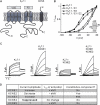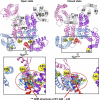Structural basis for K(V)7.1-KCNE(x) interactions in the I(Ks) channel complex
- PMID: 20206317
- PMCID: PMC3872122
- DOI: 10.1016/j.hrthm.2009.12.017
Structural basis for K(V)7.1-KCNE(x) interactions in the I(Ks) channel complex
Abstract
The cardiac I(Ks) current is involved in action potential repolarization, where its primary function is to limit action potential prolongation during sympathetic stimulation. The I(Ks) channel is mainly composed of K(V)7.1 ion channels associated with KCNE1 auxiliary subunits. The availability of KCNE1 solution structure by nuclear magnetic resonance spectroscopy in conjunction with biochemical assays addressing K(V)7.1-KCNE1 residue interactions has provided new insights into the structural basis for K(V)7.1 modulation by KCNE1. Recent evidence further suggests that KCNE2 may associate with the K(V)7.1-KCNE1 channel complex and modulate its current amplitude. Here we review recent studies in this area and discuss potential roles for multiple KCNE(x) subunits in I(Ks) generation and modulation as well as the clinical relevance of the new information.
Copyright 2010 Heart Rhythm Society. Published by Elsevier Inc. All rights reserved.
Figures



References
-
- Charpentier F, Merot J, Loussouarn G, Baro I. Delayed rectifier K(+) currents and cardiac repolarization. J Mol Cell Cardiol. 2010;48:37–44. - PubMed
-
- Lundby A, Ravn LS, Svendsen JH, Olesen SP, Schmitt N. KCNQ1 mutation Q147R is associated with atrial fibrillation and prolonged QT interval. Heart Rhythm. 2007;4:1532–1541. - PubMed
-
- McCrossan ZA, Abbott GW. The MinK-related peptides. Neuropharmacology. 2004;47:787–821. - PubMed
Publication types
MeSH terms
Substances
Grants and funding
LinkOut - more resources
Full Text Sources
Molecular Biology Databases

